There are so many new games that are coming out each year, a title has to be very special to stand out from the crowd. A designer has to approach a mechanic in a completely fresh way, or invent a completely new one. The components have to stand out and the art should be eye-catching. In short, a game entering the marketplace today has to give players a reason to want to return to it again and again. Otherwise, why wouldn’t they turn to an established classic title or some other fresh hotness?
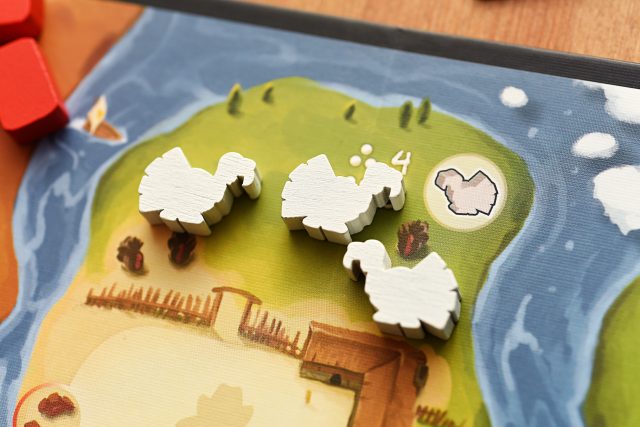 The River is the new title from Days of Wonder, and as you would expect, it has beautiful art and components. The Clay looks like bricks, the Stone like a stone. The Wood resource comes in little stacks of wood, and the Food resources are delightful little Turkey Meeples. The art by Andrew Bosley is lovely and easy to follow and the icons and graphic design of the game make it easy to quickly pick up the rules.
The River is the new title from Days of Wonder, and as you would expect, it has beautiful art and components. The Clay looks like bricks, the Stone like a stone. The Wood resource comes in little stacks of wood, and the Food resources are delightful little Turkey Meeples. The art by Andrew Bosley is lovely and easy to follow and the icons and graphic design of the game make it easy to quickly pick up the rules.
In The River, you play as Pioneers scoping out new territory, establishing settlements, and constructing buildings. By the end of the game, the Pioneer clan that has built the best new community wins the game.
 Each player gets their own River board, a boat to sail lazily down the river, and they start with four Pioneers. Another can be unlocked during the game. The River boards are broken up into spaces for Terrain tiles, but many of those spots already produce resources or contain warehouses. At the start of the game, players will each draft a Terrain tile in reverse turn order to give them an asymmetrical starting point.
Each player gets their own River board, a boat to sail lazily down the river, and they start with four Pioneers. Another can be unlocked during the game. The River boards are broken up into spaces for Terrain tiles, but many of those spots already produce resources or contain warehouses. At the start of the game, players will each draft a Terrain tile in reverse turn order to give them an asymmetrical starting point.
Mechanically, The River is a worker placement game. On a turn, you place out one of your Pioneers onto the main board and take the associated action. You can gain Terrain tiles that are added to your River board pushing you further down the River. Terrain tiles might have production symbols, or Warehouse(s), or some combination. They also could be Meadows, which grant either an immediate or ongoing bonus or can give you end game points.
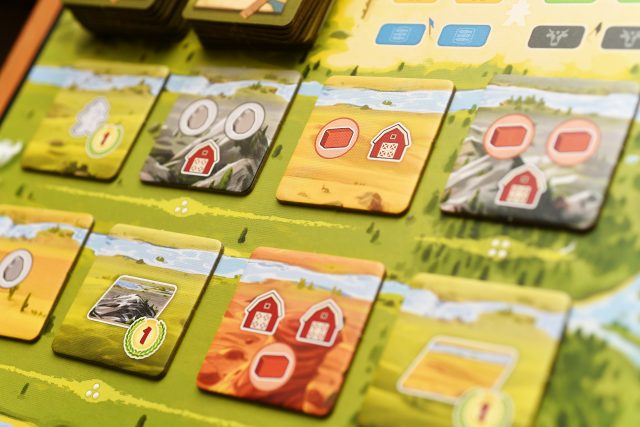 You can place out a Pioneer to gain resources. There are spaces for each resource type, allowing you to gain as many resources as there are production symbols of that type on your River board. Resources have to be stored in Warehouses, so you need to have the available space, or discard down. When you take a Food resource, you only ever get one, but they’re wild, and so very valuable. At the start of your turn, you can also exchange three resources for a Food if you so desire.
You can place out a Pioneer to gain resources. There are spaces for each resource type, allowing you to gain as many resources as there are production symbols of that type on your River board. Resources have to be stored in Warehouses, so you need to have the available space, or discard down. When you take a Food resource, you only ever get one, but they’re wild, and so very valuable. At the start of your turn, you can also exchange three resources for a Food if you so desire.
You can place a Pioneer and reserve one of the face up building cards that’s on display, or you can place one to construct a building from either your reserve (at one resource discount) or directly from the display. When you construct a building, you slide it underneath the right side of your board and then take the highest bonus token. They decrease in value as you go, so the sooner you build, the more value you’ll receive. Of course, the more valuable buildings take more time to collect the resources for, so it can be a matter of timing.
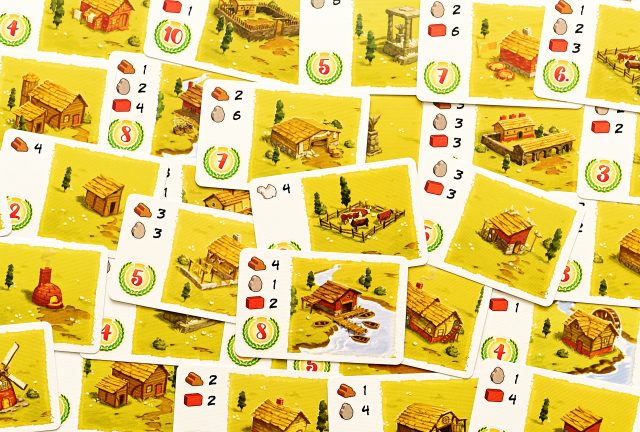 Finally, you can either take the first player marker (which is pretty self-explanatory) or swap tiles in your River board. That is more of a late game action, and the reason you’d want to do that is because at game end if you have Terrain types of the same kind in a column on your board, you receive 2 or 6 points (for two or three of the same type).
Finally, you can either take the first player marker (which is pretty self-explanatory) or swap tiles in your River board. That is more of a late game action, and the reason you’d want to do that is because at game end if you have Terrain types of the same kind in a column on your board, you receive 2 or 6 points (for two or three of the same type).
As you work your way down the River adding new Terrain tiles to your board, you’ll reach certain squares where one of your Pioneers is going to fall in love with their surroundings and want to settle. When you hit that point, you’ll lose one of your Pioneer Meeples. You’ll gain one back when you build your second Building, but the likelihood is that you’ll end the game with less than you started. An interesting element in a worker placement.
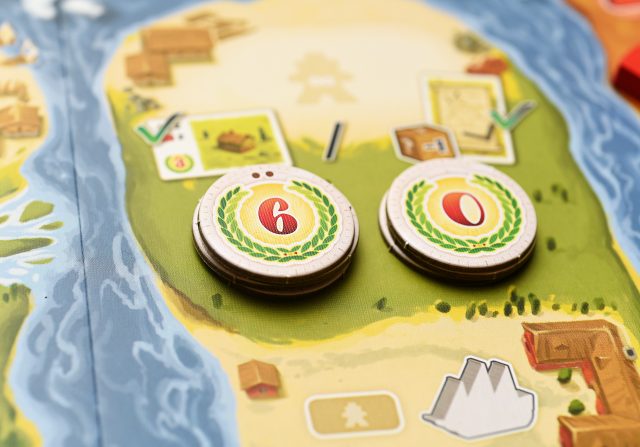 The game end is triggered when either a player has taken their 12th Terrain tile, or built their fifth Building. You finish out the current round and count up points for Buildings, Bonus tokens, and Meadow tiles. You also convert every three leftover resources into a point.
The game end is triggered when either a player has taken their 12th Terrain tile, or built their fifth Building. You finish out the current round and count up points for Buildings, Bonus tokens, and Meadow tiles. You also convert every three leftover resources into a point.
The River plays very quickly. Even at the max four players, I can’t see a game lasting longer than 45 minutes. Now here’s the thing: The River is fine. It’s a fine worker placement game with nice art and components put together in a pretty package. The problem is that it doesn’t feel particularly new or fresh. I may be looking at it through the lens of someone who sees a lot of new games each year, but if you’re reading this, I imagine you do as well. There is nothing wrong with The River. I think there is an audience for it, and it would make a good, straight forward introduction to 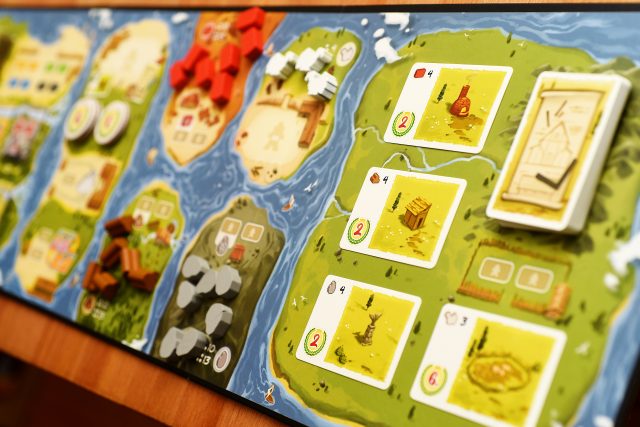 worker placement games for new gamers. I think the more hardcore gamer out there might find it a little lacking in the depth department.
worker placement games for new gamers. I think the more hardcore gamer out there might find it a little lacking in the depth department.
The River is nice to look at and pleasant to play. I recommend trying it a few times to see if it’ll have staying power with your gaming group.
————————————–
A copy of The River was generously provided by Days of Wonder for this review.
Comments
No comments yet! Be the first!